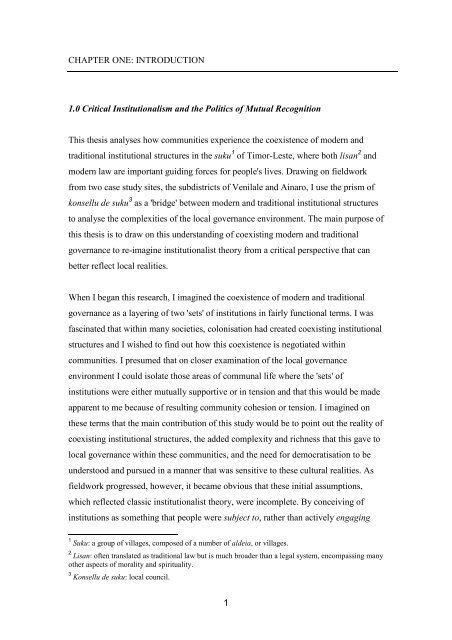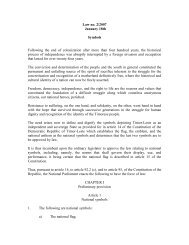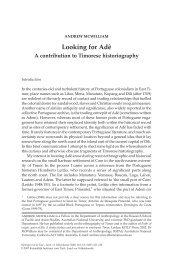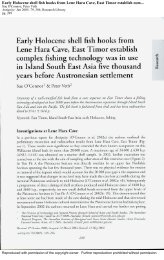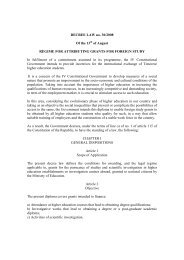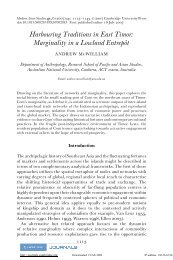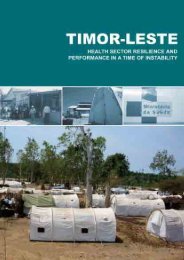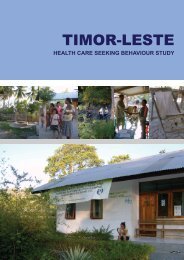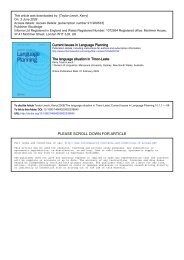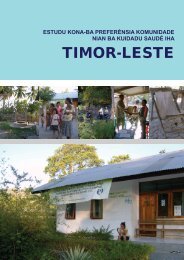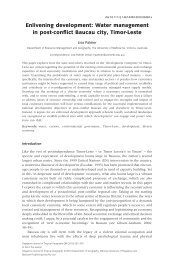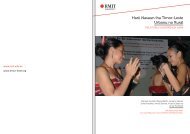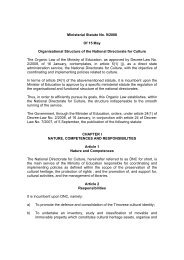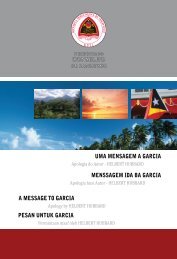Local Governance in Timor-Leste - Secretaria de Estado da Arte e ...
Local Governance in Timor-Leste - Secretaria de Estado da Arte e ...
Local Governance in Timor-Leste - Secretaria de Estado da Arte e ...
- No tags were found...
Create successful ePaper yourself
Turn your PDF publications into a flip-book with our unique Google optimized e-Paper software.
CHAPTER ONE: INTRODUCTION1.0 Critical Institutionalism and the Politics of Mutual RecognitionThis thesis analyses how communities experience the coexistence of mo<strong>de</strong>rn andtraditional <strong>in</strong>stitutional structures <strong>in</strong> the suku 1 of <strong>Timor</strong>-<strong>Leste</strong>, where both lisan 2 andmo<strong>de</strong>rn law are important guid<strong>in</strong>g forces for people's lives. Draw<strong>in</strong>g on fieldworkfrom two case study sites, the subdistricts of Venilale and A<strong>in</strong>aro, I use the prism ofkonsellu <strong>de</strong> suku 3 as a 'bridge' between mo<strong>de</strong>rn and traditional <strong>in</strong>stitutional structuresto analyse the complexities of the local governance environment. The ma<strong>in</strong> purpose ofthis thesis is to draw on this un<strong>de</strong>rstand<strong>in</strong>g of coexist<strong>in</strong>g mo<strong>de</strong>rn and traditionalgovernance to re-imag<strong>in</strong>e <strong>in</strong>stitutionalist theory from a critical perspective that canbetter reflect local realities.When I began this research, I imag<strong>in</strong>ed the coexistence of mo<strong>de</strong>rn and traditionalgovernance as a layer<strong>in</strong>g of two 'sets' of <strong>in</strong>stitutions <strong>in</strong> fairly functional terms. I wasfasc<strong>in</strong>ated that with<strong>in</strong> many societies, colonisation had created coexist<strong>in</strong>g <strong>in</strong>stitutionalstructures and I wished to f<strong>in</strong>d out how this coexistence is negotiated with<strong>in</strong>communities. I presumed that on closer exam<strong>in</strong>ation of the local governanceenvironment I could isolate those areas of communal life where the 'sets' of<strong>in</strong>stitutions were either mutually supportive or <strong>in</strong> tension and that this would be ma<strong>de</strong>apparent to me because of result<strong>in</strong>g community cohesion or tension. I imag<strong>in</strong>ed onthese terms that the ma<strong>in</strong> contribution of this study would be to po<strong>in</strong>t out the reality ofcoexist<strong>in</strong>g <strong>in</strong>stitutional structures, the ad<strong>de</strong>d complexity and richness that this gave tolocal governance with<strong>in</strong> these communities, and the need for <strong>de</strong>mocratisation to beun<strong>de</strong>rstood and pursued <strong>in</strong> a manner that was sensitive to these cultural realities. Asfieldwork progressed, however, it became obvious that these <strong>in</strong>itial assumptions,which reflected classic <strong>in</strong>stitutionalist theory, were <strong>in</strong>complete. By conceiv<strong>in</strong>g of<strong>in</strong>stitutions as someth<strong>in</strong>g that people were subject to, rather than actively engag<strong>in</strong>g1 Suku: a group of villages, composed of a number of al<strong>de</strong>ia, or villages.2 Lisan: often translated as traditional law but is much broa<strong>de</strong>r than a legal system, encompass<strong>in</strong>g manyother aspects of morality and spirituality.3 Konsellu <strong>de</strong> suku: local council.1


